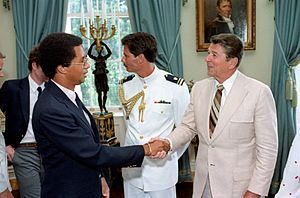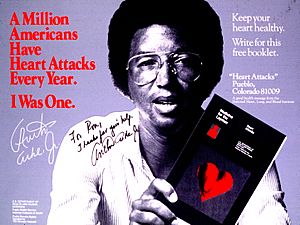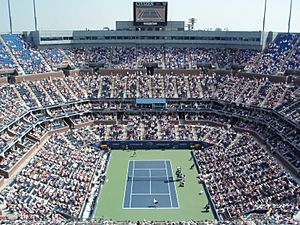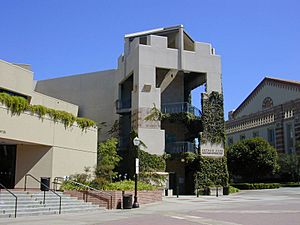Arthur Ashe facts for kids
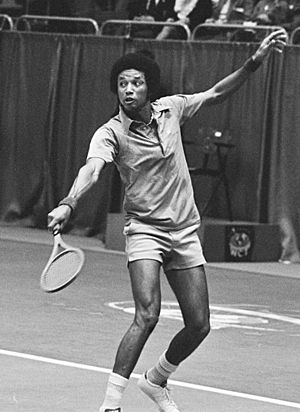
Arthur Ashe, winning the 1975 ABN World Tennis Tournament in Rotterdam
|
|
| Country (sports) | |
|---|---|
| Born | July 10, 1943 Richmond, Virginia, U.S. |
| Died | February 6, 1993 (aged 49) New York City, New York, U.S. |
| Height | 6 ft 1 in (1.85 m) |
| Turned pro | 1969 (amateur tour from 1959) |
| Retired | 1980 |
| Plays | Right-handed (one-handed backhand) |
| Prize money | $1,584,909 (ATP) |
| Int. Tennis HoF | 1985 (member page) |
| Singles | |
| Career record | 1188–371 (76.2%) in pre Open-Era & Open Era |
| Career titles | 76 (44 open era titles listed by ATP) |
| Highest ranking | No. 1 (1975, Bud Collins) No. 2 (May 10, 1976) by ATP |
| Grand Slam singles results | |
| Australian Open | W (1970) |
| French Open | QF (1970, 1971) |
| Wimbledon | W (1975) |
| US Open | W (1968) |
| Other tournaments | |
| Tour Finals | F (1978) |
| WCT Finals | W (1975) |
| Doubles | |
| Career record | 323–176 |
| Career titles | 18 (14 Grand Prix and WCT titles) |
| Highest ranking | No. 15 (August 30, 1977) |
| Grand Slam doubles results | |
| Australian Open | W (1977) |
| French Open | W (1971) |
| Wimbledon | F (1971) |
| US Open | F (1968) |
| Team competitions | |
| Davis Cup | W (1963, 1968, 1969, 1970) |
Arthur Robert Ashe Jr. (born July 10, 1943 – died February 6, 1993) was an American professional tennis player. He was a true pioneer in the sport, becoming the first black player chosen for the United States Davis Cup team. He is also the only black man to ever win the singles title at Wimbledon, the US Open, and the Australian Open.
Arthur Ashe started playing tennis when he was just six years old. He retired from the sport in 1980. In 1975, he was ranked as the world's number one tennis player by several experts. That same year, he won the ATP Player of the Year award. Later in his life, Arthur faced a serious health challenge. He learned he had a severe illness that he believed he got from a blood transfusion during one of his heart surgeries. Instead of keeping it a secret, he decided to share his story to help others. He worked hard to teach people about this illness and started organizations like the Arthur Ashe Foundation for the Defeat of AIDS and the Arthur Ashe Institute for Urban Health. He passed away at 49 years old. After his death, he was given the Presidential Medal of Freedom by President Bill Clinton.
Contents
Arthur Ashe's Life Story
Early Years and Tennis Beginnings
Arthur Ashe was born in Richmond, Virginia, on July 10, 1943. His parents were Arthur Ashe Sr. and Mattie Cordell Cunningham Ashe. He had a younger brother named Johnnie. Sadly, his mother passed away when Arthur was only seven years old. His father, a caring but strict man, raised Arthur and Johnnie. He encouraged Arthur to do well in school and sports.
The Ashe family lived in a small house inside Brookfield Park, a large public playground in Richmond. This park had tennis courts, which is where Arthur started playing at age seven. His natural talent was quickly noticed by Ron Charity, a college student and tennis instructor at the park. Ron taught Arthur the basics of tennis and encouraged him to play in local tournaments.
Arthur went to Maggie L. Walker High School. He continued to practice tennis and improve his skills. Ron Charity introduced him to Robert Walter Johnson, a doctor and tennis coach. Dr. Johnson coached Arthur at his summer tennis camp in Lynchburg, Virginia, from when Arthur was 10 until he was 17. Dr. Johnson taught Arthur not just how to play better, but also how to be a good sport and stay calm during matches. He told Arthur to never argue with an umpire's decision. In 1958, Arthur became the first African American to play in the Maryland boys' championships, which was his first time competing against white players.
In 1960, Arthur couldn't play against white teens in Richmond because of segregation laws. He also couldn't use the city's indoor courts, which were closed to Black players. So, he moved to St. Louis for his senior year of high school. There, he lived with Richard Hudlin, a teacher and tennis coach. Hudlin helped Arthur develop a strong "serve-and-volley" style of play. In 1961, Arthur became the first African American to win the U.S. Interscholastic tournament.
Arthur was featured in Sports Illustrated magazine in 1960 and 1963. He was also the first African American to win the National Junior Indoor tennis title.
College and Military Service
In 1963, Arthur received a tennis scholarship to the University of California, Los Angeles (UCLA). At UCLA, he was coached by J. D. Morgan and often practiced with his tennis hero, Pancho Gonzales. Arthur was also part of the ROTC, which meant he would serve in the military after college in exchange for tuition money. He also joined the Kappa Alpha Psi Fraternity.
After graduating with a degree in Business Administration, Arthur joined the United States Army in 1966. He worked as a data processor at the United States Military Academy at West Point. While there, he also led the academy's tennis program. He served for two years and was honorably discharged in 1969.
Professional Tennis Career
In 1963, Arthur Ashe made history as the first black player ever chosen for the United States Davis Cup team. In 1965, he was ranked the number 3 player in the U.S. He won both the singles and doubles titles at the National Collegiate Athletic Association (NCAA) championships, helping UCLA win the team title.
Arthur reached the final of the Australian Championship in 1966 and 1967, but lost both times to Roy Emerson.
In 1968, Arthur won the U.S. Amateur Championships. He also won the first US Open of the "open era." This made him the first black man to win the US Open. Because he was still an amateur to play in the Davis Cup, he couldn't accept the prize money for his US Open win. Instead, the money went to the runner-up. In December 1968, Arthur helped the U.S. team win the Davis Cup against Australia.
In 1969, the U.S. Davis Cup team won the cup again. That same year, Arthur tried to get a visa to play in the South African Open. But the South African government, which had strict apartheid laws separating people by race, denied his visa. Arthur kept trying to get a visa in the following years. He used this example of unfairness to speak out against South Africa's policies. He pushed for the U.S. to place economic restrictions on South Africa.
In January 1970, Arthur won his second major title at the Australian Open. He beat Dick Crealy in the final. In March 1970, South Africa was removed from the Davis Cup competition because of its racial policies. In September 1970, Arthur helped the U.S. team win their third straight Davis Cup.
In March 1971, Arthur reached the Australian Open final again but lost to Ken Rosewall. In June, he won the French Open men's doubles with his partner Marty Riessen.
In 1972, Arthur and other players were not allowed to play in some major tournaments, including the French Open and Wimbledon. This was due to a disagreement between tennis organizations. In September, Arthur reached the US Open final for the second time. He lost a tough five-set match to Ilie Năstase. After this match, Arthur supported the creation of the Association of Tennis Professionals (ATP). This group was formed to help professional tennis players get fair winnings and protection. Arthur became its president in 1974.
In November 1973, Arthur was finally given a visa to play in the South African Open. He lost in the final to Jimmy Connors, but won the doubles title. Even though many people boycotted South African sports, Arthur believed his presence could help change things. He thought that by competing and winning, he could show what integration looked like. Later, he changed his mind and supported the boycott of South African players.
In May 1975, Arthur beat Björn Borg to win the WCT Finals in Dallas, Texas.
On July 5, 1975, Arthur Ashe, who was almost 32, won Wimbledon on his ninth try. He defeated the favorite, Jimmy Connors, in four sets. Arthur had never beaten Connors before. Their relationship was tense because Connors had sued the ATP, where Arthur was president. During the final, Arthur wore red, white, and blue wristbands and his U.S.A. jacket. This was a clear sign of his patriotism. After the final, Connors dropped his lawsuit.
Arthur continued to play for a few more years. He won the Australian Open doubles with Tony Roche in January 1977. However, a foot injury and heart surgery in 1979 led him to retire. Arthur officially retired on April 16, 1980, at age 36. His career record was 818 wins and 260 losses, with 51 titles.
Arthur Ashe is still the only Black man to win the singles title at Wimbledon, the US Open, or the Australian Open. He is one of only two men of Black African heritage to win any Grand Slam singles title. The other is France's Yannick Noah, who won the French Open in 1983. Arthur also led the United States to win the Davis Cup three years in a row (1968–70).
Life After Retirement and Health Challenges
After retiring from tennis, Arthur Ashe took on many new roles. He wrote for Time magazine and The Washington Post. He also worked as a sports commentator for ABC Sports and HBO. He started the National Junior Tennis League and was the captain of the U.S. Davis Cup team from 1981 to 1985. In 1985, he was chosen for the International Tennis Hall of Fame.
In 1979, at age 36, Arthur had a heart attack. This was surprising because he was a fit athlete. But heart disease ran in his family. His mother had heart problems, and his father had two heart attacks. Arthur had a major heart surgery in December 1979. In 1983, he had a second heart surgery. After this, he became a national leader for the American Heart Association, teaching people about heart health.
Standing Up for Rights
During this time, Arthur was also very active in supporting civil rights. He visited South Africa to see the changes happening as the country moved towards racial equality. On January 11, 1985, he was arrested for protesting outside the South African Embassy in Washington, D.C., against apartheid. He was arrested again in 1992 for protesting outside the White House to support Haitian refugees.
Later Life and Legacy
In 1988, Arthur Ashe became ill. Doctors found that he had a serious illness that affects the body's immune system. Arthur and his doctors believed he got the illness from blood transfusions he received during his second heart surgery. He and his wife decided to keep his illness private for a while to protect their young daughter.
In 1988, Arthur published a three-volume book called A Hard Road to Glory: A History of the African-American Athlete. He worked on this book for almost six years and said it was more important than any tennis titles he had won.
In 1992, a newspaper learned about Arthur's illness. To share the news on his own terms, Arthur publicly announced his health condition on April 8, 1992. He felt forced to share the news but also felt relieved. After his announcement, he started the Arthur Ashe Foundation for the Defeat of AIDS. He worked to raise awareness about the illness. In December 1992, on World AIDS Day, he spoke to the United Nations General Assembly. He talked about the need for more awareness and research funding.
Two months before he passed away, he started the Arthur Ashe Institute for Urban Health. This institute helps improve health care in cities. He was also named Sports Illustrated magazine's Sportsman of the Year. He spent his last years writing his life story, Days of Grace, finishing it just before his death.
Passing Away
Arthur Ashe passed away on February 6, 1993, at the age of 49, due to complications from his illness. His funeral was held in Richmond, Virginia. The governor allowed his body to lie in state at the Governor's Mansion, a special honor. More than 5,000 people came to pay their respects. Arthur was buried next to his mother in Woodland Cemetery in Richmond.
In Richmond, a statue of Arthur Ashe stands on Monument Avenue. This is a place where statues of important historical figures are found. The main stadium at the USTA National Tennis Center in Flushing Meadows–Corona Park, where the US Open is played, is named Arthur Ashe Stadium in his honor.
Personal Life
In October 1976, Arthur Ashe met Jeanne Moutoussamy, a photographer. They got married on February 20, 1977, in New York City. In December 1986, Arthur and Jeanne adopted a daughter named Camera, named after her mother's job.
Arthur Ashe's Famous Quotes
- "Clothes and manners do not make the man, but where he is made they greatly improve his appearance."
- "Every time you win, it diminishes the fear a little bit. You never really cancel the fear of losing; you keep challenging it."
- "If I were to say ‘God, why me?’ about the bad things, then I should have said ‘God, why me?’ about the good things that happened in my life."
- "One important key to success is self-confidence. An important key to self-confidence is preparation."
- "True heroism is remarkably sober, very undramatic. It is not the urge to surpass all others at whatever cost, but the urge to serve others at whatever cost."
- "From what we get, we can make a living; what we give, however, makes a life."
- "Start where you are. Use what you have. Do what you can."
- "Success is a journey, not a destination. The doing is often more important than the outcome."
Awards and Honors
- In 1975, Arthur Ashe received the first ATP Player of the Year Award.
- He also won the BBC Overseas Sports Personality of the Year in 1975.
- In 1977, he received the ATP Sportsmanship Award. This award is voted on by other tennis players.
- In 1979, he was named ATP Comeback Player of the Year. He was also inducted into the Virginia Sports Hall of Fame.
- The Arthur Ashe Athletic Center, a large sports arena, was built in Richmond, Virginia, in 1982.
- In 1985, he was inducted into the International Tennis Hall of Fame.
- In 1986, Arthur won a Sports Emmy for helping write a documentary called A Hard Road to Glory.
- On June 20, 1993, after his death, Arthur Ashe was given the Presidential Medal of Freedom by President Bill Clinton. This is one of the highest awards a civilian can receive in the U.S.
- The ATP also created the Arthur Ashe Humanitarian of the Year Award in his honor.
- In 1996, a statue of Arthur Ashe was placed on Monument Avenue in Richmond, Virginia.
- The main stadium for the US Open tennis tournament is named Arthur Ashe Stadium. There is also an annual Arthur Ashe Kids' Day held there.
- In 2002, his Wimbledon win in 1975 was voted 95th in Channel 4's 100 Greatest Sporting Moments.
- In 2005, the United States Postal Service released an Arthur Ashe commemorative stamp.
- The ESPY Awards give out the Arthur Ashe for Courage Award each year. It honors someone in sports who shows great courage.
- The Arthur Ashe Student Health and Wellness Center at UCLA, his old college, is named after him.
- In 2019, a street in Richmond, Virginia, was renamed Arthur Ashe Boulevard.
Grand Slam Finals
Singles: 7 (3 titles, 4 runner-ups)
| Result | Year | Championship | Surface | Opponent | Score |
|---|---|---|---|---|---|
| Loss | 1966 | Australian Open | Grass | 4–6, 8–6, 2–6, 3–6 | |
| Loss | 1967 | Australian Open | Grass | 4–6, 1–6, 4–6 | |
| ↓ Open Era ↓ | |||||
| Win | 1968 | US Open | Grass | 14–12, 5–7, 6–3, 3–6, 6–3 | |
| Win | 1970 | Australian Open | Grass | 6–4, 9–7, 6–2 | |
| Loss | 1971 | Australian Open | Grass | 1–6, 5–7, 3–6 | |
| Loss | 1972 | US Open | Grass | 6–3, 3–6, 7–6, 4–6, 3–6 | |
| Win | 1975 | Wimbledon | Grass | 6–1, 6–1, 5–7, 6–4 | |
Doubles: 5 finals (2 titles, 3 runners-up)
| Result | Year | Championship | Surface | Partner | Opponents | Score |
|---|---|---|---|---|---|---|
| Loss | 1968 | US Open | Grass | 9–11, 1–6, 5–7 | ||
| Loss | 1970 | French Open | Clay | 2–6, 4–6, 3–6 | ||
| Win | 1971 | French Open | Clay | 6–8, 4–6, 6–3, 6–4, 11–9 | ||
| Loss | 1971 | Wimbledon | Grass | 6–4, 7–9, 8–6, 4–6, 4–6 | ||
| Win | 1977 (Jan) | Australian Open | Grass | 6–4, 6–4 |
Grand Slam Singles Performance Timeline
| W | F | SF | QF | #R | RR | Q# | A | NH |
| Tournament | 1959 | 1960 | 1961 | 1962 | 1963 | 1964 | 1965 | 1966 | 1967 | 1968 | 1969 | 1970 | 1971 | 1972 | 1973 | 1974 | 1975 | 1976 | 19771 | 1978 | 1979 | SR | W–L | |
|---|---|---|---|---|---|---|---|---|---|---|---|---|---|---|---|---|---|---|---|---|---|---|---|---|
| Australian Open | A | A | A | A | A | A | A | F | F | A | A | W | F | A | A | A | A | A | QF | A | SF | A | 1 / 6 | 25–5 |
| French Open | A | A | A | A | A | A | A | A | A | A | 4R | QF | QF | A | 4R | 4R | A | 4R | A | 4R | 3R | 0 / 8 | 25–8 | |
| Wimbledon | A | A | A | A | 3R | 4R | 4R | A | A | SF | SF | 4R | 3R | A | A | 3R | W | 4R | A | 1R | 1R | 1 / 12 | 35–11 | |
| US Open | 1R | 2R | 2R | 2R | 3R | 4R | SF | 3R | A | W | SF | QF | SF | F | 3R | QF | 4R | 2R | A | 4R | A | 1 / 18 | 53–17 | |
| Win–loss | 0–1 | 1–1 | 1–1 | 1–1 | 4–2 | 6–2 | 8–2 | 7–2 | 4–1 | 11–1 | 13–3 | 15–3 | 15–4 | 6–1 | 5–2 | 9–3 | 10–1 | 7–3 | 3–1 | 10–4 | 2–2 | 3 / 44 | 138–41 | |
1The Australian Open was held twice in 1977, in January and December.
Singles Titles (76)
Note: Ashe won 28 titles before the Open Era
| No. | Date | Tournament | Surface | Opponent | Score | |
|---|---|---|---|---|---|---|
| 1. | Jul 1961 | Eastern Clay Court Championships, Hackensack | Clay | 6–3, 2–6, 6–3, 4–6, 6–4 | ||
| 2. | Aug 1961 | American Tennis Association Championships, Hampton | ? | 6–1, 6–1, 6–3 | ||
| 3. | Apr 1962 | Ojai Tennis Tournament, Ojai | Hard | 6–3, 6–2 | ||
| 4. | Jan 1962 | Detroit Invitational, Detroit | ? | 6–2, 6–2 | ||
| 5. | Aug 1962 | American Tennis Association Championships, Wilberforce | ? | 6–1, 6–2, 6–0 | ||
| 6. | Sep 1963 | Pacific Southwest Championshipss, Los Angeles | Hard | 2–6, 9–7, 6–2 | ||
| 7. | Dec 1963 | U.S. Hard Court Championships | Hard | 6–3, 12–10 | ||
| 8. | Aug 1964 | Eastern Grass Court Championships, New Jersey | Grass | 4–6, 8–6, 6–4, 6–3 | ||
| 9. | Sep 1964 | Perth Amboy Invitational, New Jersey | ? | 6–3, 8–6, 6–2 | ||
| 10. | Sep 1965 | Colonial National Invitational, Texas | ? | 6–3, 6–4 | ||
| 11. | Nov 1965 | Queensland Lawn Tennis Championships, Australia | Grass | 3–6, 6–2, 6–3, 3–6, 6–1 | ||
| 12. | Dec 1965 | South Australian Championships | Grass | 7–9, 7–5, 6–0, 6–4 | ||
| 13. | Jan 1966 | Western Australian Championships, Perth | ? | 3–6, 6–2, 6–3, 6–4 | ||
| 14. | Jan 1966 | Tasmanian Championships, Australia | ? | 6–4, 6–4, 12–10 | ||
| 15. | Mar 1966 | Thunderbird Invitational Tennis Tournament, Phoenix | ? | 3–6, 6–3, 6–2 | ||
| 16. | Apr 1966 | Caribe Hilton Invitational, Puerto Rico | ? | 6–3, 6–4, 6–3 | ||
| 17. | Apr 1966 | Dallas Invitational, Texas | ? | 7–9, 6–4, 6–4 | ||
| 18. | Feb 1967 | Philadelphia International, USA | ? | 7–5, 9–7, 6–3 | ||
| 19. | Feb 1967 | Concord International Indoor, Kiamesha Lake | Hard (i) | 6–3, 2–6, 6–2 | ||
| 20. | Feb 1967 | Western Indoor Championship | ? | 3–6, 6–3, 6–3 | ||
| 21. | Apr, 1967 | Long Island Invitational | ? | round-robin | ||
| 22. | Jul 1967 | National Clay Court Championship, USA | Clay | 4–6, 6–3, 6–1, 7–5 | ||
| 23. | 1967 | Long Island Masters, New York | ? | 31–27 | ||
| 24. | Jan 1968 | Caribe Hilton Invitational, Puerto Rico | ? | 6–4, 6–4 | ||
| 25. | Feb 1968 | *Fidelity Bankers Invitational, Richmond | ? | 6–2, 6–1 | ||
| 26. | Feb 1968 | Concord International Indoor, Kiamesha Lake | Hard (i) | 6–3, 15–13 | ||
| 27. | Mar 1968 | *Garden Challenge Trophy, New York | ? | 6–4, 6–4, 7-5 | ||
| 28. | Apr 1968 | *Charlotte Invitation, Charlotte | ? | 6–2, 6–4 | ||
| ↓ Open Era ↓ | ||||||
| 29. | Jun 1968 | West of England Championships, Bristol | Grass | 6–4, 6–3 | ||
| 30. | Jul 1968 | *Pennsylvania Lawn Tennis Championships, Haverford | Grass | 6–2, 6–3, 6–3 | ||
| 31. | Aug 1968 | *U.S. Amateur Championships, Boston | Grass | 4–6, 6–3, 8–10, 6–0, 6–4 | ||
| 32. | Sep 1968 | *US Open, New York | Grass | 14–12, 5–7, 6–3, 3–6, 6–3 | ||
| 33. | Sep 1968 | Las Vegas Invitational | ? | 9–7, 6–3 | ||
| 34. | Dec 1968 | *Queensland Championships, Brisbane, Australia | Grass | 6–4, 1–6, 9–7, 4–6, 7-5 | ||
| 35. | Feb 1969 | Balboa Bay Club Invitational | ? | shared title, rain | ||
| 36. | Apr 1969 | *Caribe Hilton International, San Juan, Puerto Rico | Hard | 5–7, 5–7, 6–0, 6–4, 6–3 | ||
| 37. | Jan 1970 | *Australian Open, Melbourne | Grass | 6–4, 9–7, 6–2 | ||
| 38. | Feb 1970 | *Richmond WCT, Richmond | Carpet (i) | 6–2, 13–11 | ||
| 39. | Mar 1970 | *Jacksonville Open, Florida | Clay | 6–3, 4–6, 6–3 | ||
| 40. | Apr 1970 | *Caribe Hilton International, San Juan, Puerto Rico | Hard | 6–4, 6–3, 1–6, 6–3 | ||
| 41. | Apr 1970 | Bacardi Invitational, Bermuda | ? | 8–6, 7–5 | ||
| 42. | May 1970 | *Glenwood Manor Invitational, Kansas City | Hard | 7–6, 6–1 | ||
| 43. | May 1970 | *Central California Championships, Sacramento | Hard | 6–4, 6–2, 3–6, 10–8 | ||
| 44. | Jun 1970 | John Player tournament | ? | round-robin | ||
| 45. | Sep 1970 | Seattle Tennis Invitational | ? | 6–3, 6–4 | ||
| 46. | Sep 1970 | *Berkeley, California | Hard | 6–4, 6–2, 6–4 | ||
| 47. | Oct 1970 | *Denver Invitational, Denver, USA | Hard (i) | 6–2, 5–6, 6–3 | ||
| 48. | Nov 1970 | *Paris, France | Carpet (i) | 7–6, 6–4, 6–3 | ||
| 49. | Apr 1971 | *Charlotte, USA | Hard | 6–3, 6–3 | ||
| 50. | Nov 1971 | *Stockholm WCT, Sweden | Hard (i) | 6–1, 3–6, 6–2, 1–6, 6–4 | ||
| 51. | Jul 1972 | *Louisville WCT | Clay | 6–4, 6–4 | ||
| 52. | Sep 1972 | *Montreal WCT | Carpet (i) | 7–5, 4–6, 6–2, 6–3 | ||
| 53. | Nov 1972 | *Rotterdam WCT | Carpet (i) | 3–6, 6–2, 6–1 | ||
| 54. | Nov 1972 | *Rome WCT Winter Finals | Carpet (i) | 6–2, 3–6, 6–3, 3–6, 7–6 | ||
| 55. | Feb 1973 | *Chicago WCT | Carpet (i) | 3–6, 7–6(11–9), 7–6(7–2) | ||
| 56. | Jul 1973 | *Washington | Clay | 6–4, 6–2 | ||
| 57. | Feb 1974 | *Bologna WCT | Carpet (i) | 6–4, 7–5 | ||
| 58. | Mar 1974 | *Barcelona WCT | Carpet (i) | 6–4, 3–6, 6–3 | ||
| 59. | Nov 1974 | *Stockholm Open | Hard (i) | 6–2, 6–2 | ||
| 60. | Feb 1975 | *Barcelona WCT | Carpet (i) | 7–6, 6–3 | ||
| 61. | Feb 1975 | *Rotterdam WCT | Carpet (i) | 3–6, 6–2, 6–4 | ||
| 62. | Mar 1975 | *Munich WCT | Carpet (i) | 6–4, 7–6 | ||
| 63. | Apr 1975 | *Stockholm WCT | Carpet (i) | 6–4, 6–2 | ||
| 64. | May 1975 | *Dallas WCT Finals | Carpet (i) | 3–6, 6–4, 6–4, 6–0 | ||
| 65. | Jun 1975 | Kent Championships | Grass | 7–5, 6–4 | ||
| 66. | Jun 1975 | *Wimbledon | Grass | 6–1, 6–1, 5–7, 6–4 | ||
| 67. | Sep 1975 | *Los Angeles | Carpet (i) | 3–6, 7–5, 6–3 | ||
| 68. | Sep 1975 | *San Francisco | Carpet (i) | 6–0, 7–6(7–4) | ||
| 69. | Jan 1976 | *Columbus WCT | Carpet (i) | 3–6, 6–3, 7–6(7–4) | ||
| 70. | Jan 1976 | *Indianapolis WCT | Carpet (i) | 6–2, 6–7, 6–4 | ||
| 71. | Feb 1976 | *Richmond WCT | Carpet (i) | 6–2, 6–4 | ||
| 72. | Feb 1976 | *Rome WCT | Clay | 6–2, 0–6, 6–3 | ||
| 73. | Feb 1976 | *Rotterdam WCT | Carpet (i) | 6–3, 6–3 | ||
| 74. | Apr 1978 | *San Jose | Carpet (i) | 6–7, 6–1, 6–2 | ||
| 75. | Aug 1978 | *Columbus | Clay | 6–3, 6–4 | ||
| 76. | Sep 1978 | *Los Angeles | Carpet (i) | 6–2, 6–4 | ||
Images for kids
See Also
 In Spanish: Arthur Ashe para niños
In Spanish: Arthur Ashe para niños


